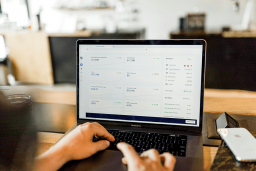If you are reading this, you are likely wondering how to actually go about starting an online retail business but still have to dot some is. What prevents you from taking the first step right now? In this article, we’ll try to make the process of establishing an online retail store simple. Spoiler: adapt and innovate.
Key points
- The Definition Of Online Retail Business. Retail and e-Commerce: What’s The Difference?
- Retail Trends In 2022: What Is The Future Of Shopping You Should Be Ready For?
- The Retailer’s Checklist For Starting A Retail Business
- How Can Custom Software Development Services Providers Transform Your Business?
- Final Words
The Definition Of Online Retail Business. Retail and e-Commerce: What’s The Difference?
The notion of “eCommerce” refers to any type of business or commercial transaction that uses the Internet as a medium without issuing any paper reports. It means that customers can start and finalize purchases within minutes. eCommerce encompasses activities like online banking, ticketing, auctions, etc.
Selling goods from a single point like brick and mortar store is called retail.
There is a slight difference between eCom and online retail: eCommerce involves more marketing efforts and, thus, is more costly. IKEA, The North Face, and Patagonia are good examples of online retail companies. For example, IKEA scores well on all retailing essentials: it is famous for its cost cuts and regular price reductions, highly differentiated products, and unparalleled customer experience, and most of the selling items could be found online.
Electronic commerce offers a more significant audience coverage compared to traditional retail. eCommerce is an effective way to extend your business. It has proved to be more effective in terms of lower transaction costs, is available 24/7, and is easier to use and operate as involves only digital gadgets.
Retail Trends In 2022: What Is The Future Of Shopping You Should Be Ready For?
Every 50 years or so, the retail industry experiences some tipping point. Retailing significantly changed when the Internet came along. And now customers have more choices than ever. Will eCommerce replace retail business?
Though worldwide online retail sales will slow down due to the in-store retail’s rapid bounceback after two years of the coronavirus pandemic, global online spending is expected to account for more than 20% of overall retail sales in 2022 and beat the amount of $7 trillion by 2025. And soon it’ll be difficult to measure it as more combinations of purchasing journies come about.
The key to any entrepreneur’s success is anticipation. Align your strategy with the global retail trends we’ve prepared for you.
Omnichannel
Digital retailing is quickly evolving into something new – omnichannel retailing. Buy in a physical shop or buy online – only two options were available when eCommerce was born. Everything has significantly changed today.
The concept name reflects the way interaction between sellers and customers happens: via multiple channels, like webpages, brick-and-mortar stores, catalogs, call centers, all types of social media, mobile phones, gaming appliances, TV sets, home services, direct e-mail, and more.
Big Data For Small Companies
Going omnichannel makes small and medium business revise their attitude to the modern customers’ spending habits and understand them better. It’s crucial to invest in retail analytics tools that provide further applicable solutions. These will be accompanied by raising concerns about privacy.
Upselling And Cross-selling
Artificial intelligence (AI) and machine learning (ML) will help predict shopping habits based on browsing and purchase history. AI is able to craft the site for each unique visitor. And with the help of ERP and CRM systems with ML functions, you can increase your sales via upselling and cross-selling.
Headless CMS
Headless technology eliminates page templates, server code, and other components that can slow down a site. While consumer expectations are always rising, a headless approach allows businesses to quickly improve the performance of their platform so they can better handle traffic spikes or increased sales.
Diversity Of Payment Methods
To attract customers and encourage them to spend more retailers should provide an alternative to usual payment methods. Interest-free payment options such as “buy now, pay later” or “one-click” offer more flexibility at the checkout and grow in popularity.
Just consider convincing facts:
- Amazon joined the BNPL market in 2020,
- 93% of Indians have no access to credits according to the local Fintech firm MobiKwik, and they opt for easy loans,
- 80% BNPL global market is northwestern EU residents.
New delivery expectations
Customers heightened their expectations on how quickly they receive goods bought online, especially encouraged by Amazon’s 1-day delivery time. Grocery stores, shopping centers, and other crowded places will have even more lockers where buyers can collect their orders themselves.
Sustainability
The new generation of shoppers cares, and they are more willing to communicate with socially responsible brands. It’s time to think anew.
The Retailer’s Checklist For Starting A Retail Business
To fully immerse in launching an online retail store let’s split it into the clear and actionable steps that will help you make better decisions. Here follows what you need to do to make your online business viable:
1. Select Industry And Product Line
There are two possible options:
- you already manufacture or sell something or
- you have to develop your offering from scratch.
Country, region, city – all this can be configured to view the statistics of requests. What product is interesting in your location? Everything that people ask in the network is shown in statistics.
Google Ads Keyword Planner shows how often people search for certain words, and how these searches change over time. You can understand the relevance of the product. The advertising campaign will require investments – the tool will help determine the budget.
2. Define Target Audience
Without a target audience, your product will be unfocused and without purpose. It’s the audience that guides your product through its lifetime and influences where and how you market, pointing to the price, ToV, and engagements in general. When you are done with your ideal buyers, make sure your target audience fits in our ideal market.
3. Register Your Business
When setting up an online retail business, you’ll have to choose a legal structure. Besides, you’ll also have to take care of all papers and permits related to your business. Make a checklist of everything concerning taxes, hiring, advertising, environmental protection, etc. To avoid trouble – hire a specialist.
4. Investigate Customer Needs
Every product is produced to satisfy some needs or solve a problem. You have to investigate why customers are interested in similar products. Reach out to your buyers.
5. Suppliers
Focus on your values and choose your suppliers based on them. Country of origin, composition, and sustainability are among other possible criteria. Even if you produce your own goods you still have to work with vendors and suppliers.
6. Create Your Brand
58% of buyers find themselves brand loyal, and 31% state that they always purchase a product from specific brands when spending online (Source: JungleScout). Developing your own brand matters.
The brand name should convey some meaning. Once you come up with the idea of your business name, check it for trademark filings in the regional Patent Office to be sure another entrepreneur is not operating under your business’s potential name.
Make sure the corresponding URL is available, register your domain, and create social media accounts.
7. Select Platform, Launch and Optimize Your Website
The next step would be to set up an online shopping cart. An appropriate eCommerce platform with desired features and functionalities will lead traffic to your website, leads, and sales. You must decide if you need software supporting a large inventory or a platform with POS capabilities.
Perhaps, your client’s number one concern would be safety issues. SSL certificates will make your buyers confident that sharing their credit card details is safe.
8. Promote The Project
Being present online with the best product in the world is not enough-this area is highly competitive. Despite the mass transition of sales to online, the client needs more touch points. If previously 1-2 touches were enough to attract a customer, now the length of the purchase process has increased, and the customer interacts with the company many times through different channels: a website, cold calls, social networks, YouTube, messengers, visits to a retail outlet, emails, etc. On average it takes 6-8 touch points to make a viable sales lead, however, this number may vary depending on the prospect. Furthermore, we observe growth in online interactions (compared to offline) which is 60% in 2021 versus 42% in 2019. It is necessary to ensure complete synchronization of information.
In the long term prospect, SEO is fundamental for your marketing activities. A successful marketing campaign would be a combination of:
- presence on online directories,
- affiliate marketing,
- cooperation with influencers,
- SMM,
- online advertising (GoogleAds, FacebookAds, etc),
- content marketing, and others.
How Can Custom Software Development Services Providers Transform Your Business?
Getting ready for your first try won’t be as successful as you expected. Though achieving your most ambitious plans is easier with a reliable digital transformation services provider.
By turning to Soloway.tech you get a wide range of software development solutions for online stores, marketplaces, and retailers to improve the company’s bottom line. You get access to a dedicated team that can:
- design and program a unique platform or website from scratch or based on an existing platform,
- develop your custom application or upgrade the existing one according to your business demands,
- build and integrate new solutions, features, tools, etc,
- support and maintain any type of system you work with to keep it running smoothly.
With a thoughtfully prepared roadmap and all dependencies included, soloway.tech team will prepare your business for the implementation of the new features.
Final Words
The future of online shopping seems to be very similar to what we are observing nowadays. Retailers should meet customers’ needs and reinvent themselves to stay relevant. They should put innovation at the core of their development. There is no better moment to leverage retail technology and invest in it than now.
Hopefully, this article will bring you closer to your goal. If you got interested in a partner who will lead your company through the digital transformation process or have questions left, reach out to us — let’s see what you could do.





